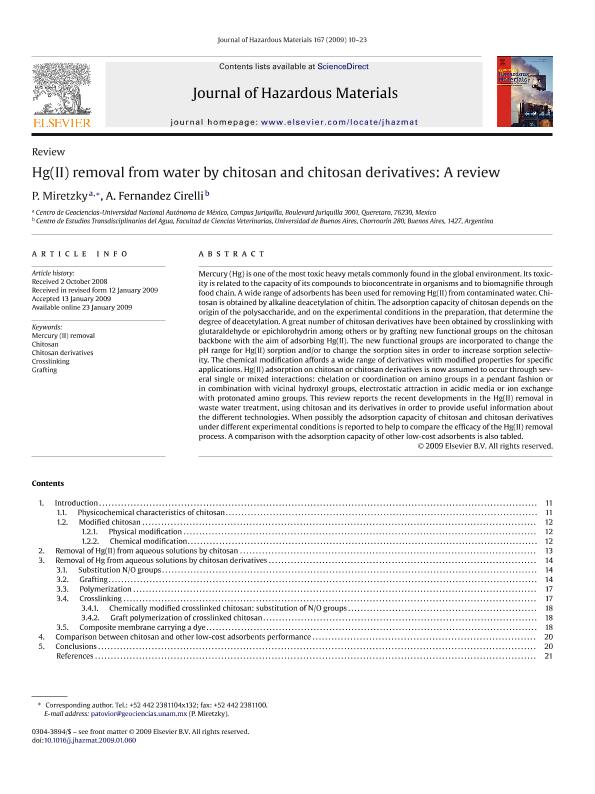Mostrar el registro sencillo del ítem
dc.contributor.author
Miretzky, Patricia
dc.contributor.author
Fernandez Cirelli, Alicia

dc.date.available
2021-04-22T23:09:45Z
dc.date.issued
2009-08-15
dc.identifier.citation
Miretzky, Patricia; Fernandez Cirelli, Alicia; Hg(II) removal from water by chitosan and chitosan derivatives: A review; Elsevier Science; Journal of Hazardous Materials; 167; 1-3; 15-8-2009; 10-23
dc.identifier.issn
0304-3894
dc.identifier.uri
http://hdl.handle.net/11336/130744
dc.description.abstract
Mercury (Hg) is one of the most toxic heavy metals commonly found in the global environment. Its toxicity is related to the capacity of its compounds to bioconcentrate in organisms and to biomagnifie through food chain. A wide range of adsorbents has been used for removing Hg(II) from contaminated water. Chitosan is obtained by alkaline deacetylation of chitin. The adsorption capacity of chitosan depends on the origin of the polysaccharide, and on the experimental conditions in the preparation, that determine the degree of deacetylation. A great number of chitosan derivatives have been obtained by crosslinking with glutaraldehyde or epichlorohydrin among others or by grafting new functional groups on the chitosan backbone with the aim of adsorbing Hg(II). The new functional groups are incorporated to change the pH range for Hg(II) sorption and/or to change the sorption sites in order to increase sorption selectivity. The chemical modification affords a wide range of derivatives with modified properties for specific applications. Hg(II) adsorption on chitosan or chitosan derivatives is now assumed to occur through several single or mixed interactions: chelation or coordination on amino groups in a pendant fashion or in combination with vicinal hydroxyl groups, electrostatic attraction in acidic media or ion exchange with protonated amino groups. This review reports the recent developments in the Hg(II) removal in waste water treatment, using chitosan and its derivatives in order to provide useful information about the different technologies. When possibly the adsorption capacity of chitosan and chitosan derivatives under different experimental conditions is reported to help to compare the efficacy of the Hg(II) removal process. A comparison with the adsorption capacity of other low-cost adsorbents is also tabled. © 2009 Elsevier B.V. All rights reserved.
dc.format
application/pdf
dc.language.iso
eng
dc.publisher
Elsevier Science

dc.rights
info:eu-repo/semantics/openAccess
dc.rights.uri
https://creativecommons.org/licenses/by-nc-sa/2.5/ar/
dc.subject
CHITOSAN
dc.subject
CHITOSAN DERIVATIVES
dc.subject
CROSSLINKING
dc.subject
GRAFTING
dc.subject
MERCURY (II) REMOVAL
dc.subject.classification
Otras Ciencias Químicas

dc.subject.classification
Ciencias Químicas

dc.subject.classification
CIENCIAS NATURALES Y EXACTAS

dc.title
Hg(II) removal from water by chitosan and chitosan derivatives: A review
dc.type
info:eu-repo/semantics/article
dc.type
info:ar-repo/semantics/artículo
dc.type
info:eu-repo/semantics/publishedVersion
dc.date.updated
2021-04-19T14:19:04Z
dc.journal.volume
167
dc.journal.number
1-3
dc.journal.pagination
10-23
dc.journal.pais
Países Bajos

dc.journal.ciudad
Amsterdam
dc.description.fil
Fil: Miretzky, Patricia. Universidad Nacional Autónoma de México; México
dc.description.fil
Fil: Fernandez Cirelli, Alicia. Universidad Nacional Autónoma de México; México. Universidad de Buenos Aires. Facultad de Ciencias Veterinarias. Centro de Estudios Transdisciplinarios del Agua; Argentina. Consejo Nacional de Investigaciones Científicas y Técnicas. Oficina de Coordinación Administrativa Parque Centenario; Argentina
dc.journal.title
Journal of Hazardous Materials

dc.relation.alternativeid
info:eu-repo/semantics/altIdentifier/doi/https://doi.org/10.1016/j.jhazmat.2009.01.060
dc.relation.alternativeid
info:eu-repo/semantics/altIdentifier/url/https://www.sciencedirect.com/science/article/pii/S0304389409000880
dc.relation.alternativeid
info:eu-repo/semantics/altIdentifier/url/https://pubmed.ncbi.nlm.nih.gov/19232467/
Archivos asociados
